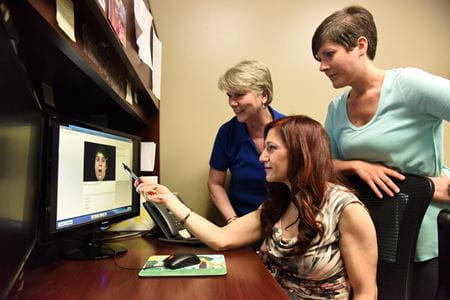INDIANAPOLIS—A system created to help people with brain injuries recognize others’ emotions, co-developed by an Indiana University School of Medicine researcher, has been designated a “practice standard” that medical professionals should add to their tool kits when treating such patients.
The recognition, published in the March 26, 2019, online edition of the Archives of Physical Medicine and Rehabilitation, will hopefully significantly increase the number of traumatic brain injury patients receiving help recognizing emotions, said Dawn Neumann, PhD, associate professor of physical medicine and rehabilitation at IU School of Medicine.
People who have suffered traumatic brain injuries often have difficulty understanding the emotions being expressed by others, missing non-verbal cues such as facial expressions and resulting in inappropriate responses and misunderstandings. Such emotion recognition deficits have also been linked to worse social outcomes.
With the Facial Affect Recognition (FAR) training program, developed by Neumann and colleagues, a therapist uses software that includes pictures of facial expressions in a one-on-one session to help a patient recognize how others are feeling and to better understand his or her own emotions.
Neumann is also research director at the Rehabilitation Hospital of Indiana (RHI), where she additionally oversees the Indiana University Interaction and Functional Assessment of Communication and Emotion (InterFACE) Center.
In research published in the Journal of Head Trauma Rehabilitation in 2015, Neumann reported that in a study of 71 people with traumatic brain injuries, those receiving what then was called the Faces Intervention were significantly better at recognizing facial expressions than those who did not, and the benefits persisted throughout a six-month follow-up period.
Assessing the quality of that research, the authors of the March Archives of Physical Medicine and Rehabilitation paper—“Evidence-Based Cognitive Rehabilitation: Systematic Review of the Literature From 2009 Through 2014”—recommended that based on “substantive evidence of effectiveness,” the Facial Affect Recognition system be added as a practice standard, meaning that clinicians should specifically consider it for their patients.
It’s an important development, Neumann said, because a lack of such tools has meant more than 50 percent of patients with traumatic brain injury are not treated for emotion recognition deficits even though their clinicians recognize the problems exist.
“You now have a group of professionals who are making this recommendation, a team of experts supporting its use, which should make its adoption by clinicians more likely,” she said.
That transition into clinical application is already underway. Neumann has been working with therapists at RHI, providing them with this new tool for treatment and training them how to use it.
“Until I learned this program I didn’t have a good tool for teaching people how to recognize and regulate their emotions,” said Beth Helton, MA/CCC-SLP, CBIS, a speech pathologist at RHI. “Through this, we can not only help them regulate their emotions, but also express them.”
According to Elizabeth Strong, therapy manager at RHI, this development will help rehabilitation therapists provide a comprehensive approach to treatment for their patients.
“As an interdisciplinary team we want to address the whole person. So it’s not just asking ‘can you walk or can you talk,’ but also looking at emotions, which are incredibly important in our everyday life,” said Strong, MA/CCC-SLP, CBIS. “Organizationally in the therapy department we are really promoting the implementation of evidence-based practice, so this feeds right into that.”
Since the Archives article was published, Neumann has received numerous inquiries from around the world from professionals working with traumatic brain injury patients. She makes the software and training manual for the FAR system available to qualified clinicians at no cost.
Neumann and her team recently submitted a proposal for federal funding to study whether the FAR system can be successfully implemented long distance, with the therapist working with the patient via a videoconferencing system.
Co-developers of the Faces Intervention and co-authors of the 2015 journal article that reported its success, in addition to Neumann, were Barbra Zupan, then of Brock University, Ontario, Canada; Duncan R. Babbage, then of Auckland University of Technology, New Zealand; and Barry Willer, at The State University of New York, Buffalo.
###
IU School of Medicine is the largest medical school in the U.S. and is annually ranked among the top medical schools in the nation by U.S. News & World Report. The school offers high-quality medical education, access to leading medical research and rich campus life in nine Indiana cities, including rural and urban locations consistently recognized for livability.




